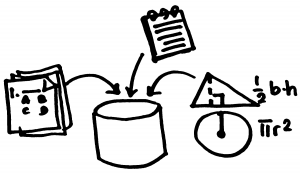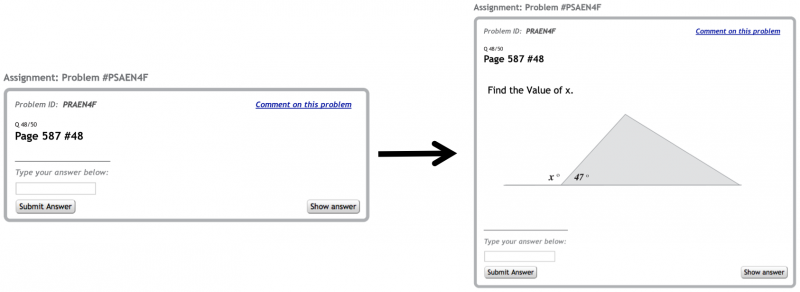All Content In One Place
| All Content In One Place | |
| Contributors | Paul Salvador Inventado, Peter Scupelli |
|---|---|
| Last modification | May 12, 2017 |
| Source | Inventado and Scupelli (in press 2015)[1] |
| Pattern formats | OPR Alexandrian |
| Usability | |
| Learning domain | General |
| Stakeholders | Teachers Students |
| Production | |
| Data analysis | Student affect and interaction behavior in ASSISTments |
| Confidence | |
| Evaluation | PLoP 2015 shepherding and writing workshop Talk:ASSISTments |
| Application | ASSISTments |
| Applied evaluation | ASSISTments |
Embed all content such as images, animations, videos, or text into the problem instead of asking students to switch between various sources [1].
Context
Content creators create problem-solving activities in an online learning system so students can practice solving problems. The All Content In One Place design pattern described below is the result of an implementation of the Try It Yourself design pattern in an online learning system.
Problem
Content creators may find it easier to provide links to existing content (e.g., exercises in the textbook, images, videos, animations, websites) instead of copying the content of the problem into the online learning system, but scattering problem content across multiple locations makes the learning task more difficult for learners.
Forces
- Permission. Some content cannot be copied directly into the online learning system because of copyright rules (e.g., text, images).
- Replication difficulty. Some content are difficult or time consuming to replicate in an online learning system (e.g., copying text, images, video).
- Accessibility. Students may be unable to access the necessary content that is referenced in the problem (e.g., no textbook, no permission to access content, limited internet access).
- Split-attention effect. Students need to integrate information across multiple locations when they switch between different content sources (e.g., textbook, handouts, external website). This increases cognitive load, which impairs performance and unnecessarily complicates the learning task at hand [2].
- Affect. Students can get annoyed by repeatedly going back and forth between content sources to solve a problem. Negative emotions might hurt learning (e.g., frustration, disengagement) and often result in failure to complete assigned problem sets.[3].
Solution
Therefore, gain access to the content and embed it into the online learning system instead of asking students to switch to a different resource (e.g., looking for a problem in the textbook, opening a new browser window, downloading content).
Consequences
Benefits
- Third-party content can be used after getting permission to use it.
- It takes less effort to embed content instead of copying it.
- Students do not need to worry about integrating content across multiple locations because the content is in the system.
- Students focus on an integrated content source instead of switching between multiple locations.
- Students are less likely to experience negative emotions when they can focus on the learning activity and are not subjected to unnecessary cognitive load.
Liabilities
- Teachers have no choice but to build new content if they lack permission to use copyrighted content or cannot find alternative open-source learning content.
- Some online learning systems have limited or lack support to embed external content. Teachers will need to manually add the content into the online learning system in this case.
- Neither the content creator nor the online learning system has control over external content. Unless the system automatically replicates content, access to the content may be lost if the owner discontinues support for it.
Evidence
Literature
Several studies have shown that split-attention increases cognitive load and have negative effects on learning in various settings such as: instructional manual usage while learning to use computer software[4], split-attention worked examples for geometry[5], and split-attention worked examples in math word problems[6].
Discussion
Shepherds, writing workshop participants, and learning system stakeholders (i.e., data mining experts, learning scientists, and educators) agreed that the problem recurs in online learning systems and the solution could properly address the problem. This pattern underwent shepherding and was refined through a writing workshop at PLoP 2015.
Data
According to an ASSISTments' math online learning system data, boredom and gaming behavior correlated with problems that referred students to content in their textbook[7].
Example
Most online learning systems either use their own content or embed existing content (e.g., Cognitive Tutor Algebra[8], SQL-Tutor[9], ASSISTments [10]). When content is copyrighted, access may be requested from the owner or alternative non-copyrighted content may be used. In the case of the ASSISTments online learning system, some of its Math exercises are copied from publicly available textbooks, such as EngageNY. Content may be embedded into the system using iframes that contain external websites or loaded directly into the page (e.g., external images, animations, videos, text). For example, videos used in the problem content or feedback are embedded into the system so students do not need to view them in separate browser windows.
Figure on the left illustrates a particular case wherein a teacher provided instructions to access a math problem from the textbook instead of copying the content directly into the online learning system. Figure on the right illustrates the same math problem, but with the content embedded into the system.
Related patterns
The All Content In One Place design pattern implements the Keep It Simple design pattern by removing extraneous tasks that do not help students learn. Implement the All Content In One Place design pattern whenever students are asked to perform learning activities such as those implemented in the Try It Yourself, Build and Maintain Confidence, or One Concept Several Implementations design patterns.
References
- ↑ 1.0 1.1 Inventado, P.S. & Scupelli, P. (in press 2015). A Data-driven Methodology for Producing Online Learning System Design Patterns. In Proceedings of the 22nd Conference on Pattern Languages of Programs (PLoP 2015). New York:ACM.
- ↑ Sweller, J. (2004). Instructional design consequences of an analogy between evolution by natural selection and human cognitive architecture. Instructional science, 32(1-2), 9-31.
- ↑ D’Mello, S., and Graesser, A. (2012). Dynamics of affective states during complex learning. Learning and Instruction, 22(2), 145-157.
- ↑ Cerpa, N., Chandler, P., and Sweller, J. (1996). Some conditions under which integrated computer-based training software can facilitate learning. Journal of Educational Computing Research, 15, 345-368.
- ↑ Sweller, J., Chandler, P., Tierney, P., and Cooper, M. (1990). Cognitive load as a factor in the structuring of technical material. Journal of Experimental Psychology: General, 119(2), 176.
- ↑ Mwangi, W., and Sweller, J. (1998). Learning to solve compare word problems: The effect of example format and generating self-explanations. Cognition and instruction, 16(2), 173-199.
- ↑ Inventado, P.S., Scupelli, P., Van Inwegen, E., Ostrow, K., Heffernan, N., Baker, R., Slater, S., and Ocumpaugh, J. (In preparation). Design Subtleties Driving Differential Attrition.
- ↑ Aleven, V., Mclaren, B., Roll, I., and Koedinger, K. (2006). Toward meta-cognitive tutoring: A model of help seeking with a Cognitive Tutor. International Journal of Artificial Intelligence in Education, 16(2), 101-128.
- ↑ Mitrovic, A. (2012). Fifteen years of constraint-based tutors: what we have achieved and where we are going. User Modeling and User-Adapted Interaction, 22(1-2), 39-72.
- ↑ Heffernan, N.T. and Heffernan, C.L. (2014). The ASSISTments Ecosystem: Building a Platform that Brings Scientists and Teachers Together for Minimally Invasive Research on Human Learning and Teaching. International Journal of Artificial Intelligence in Education 24, 4 (2014), 470-497.

